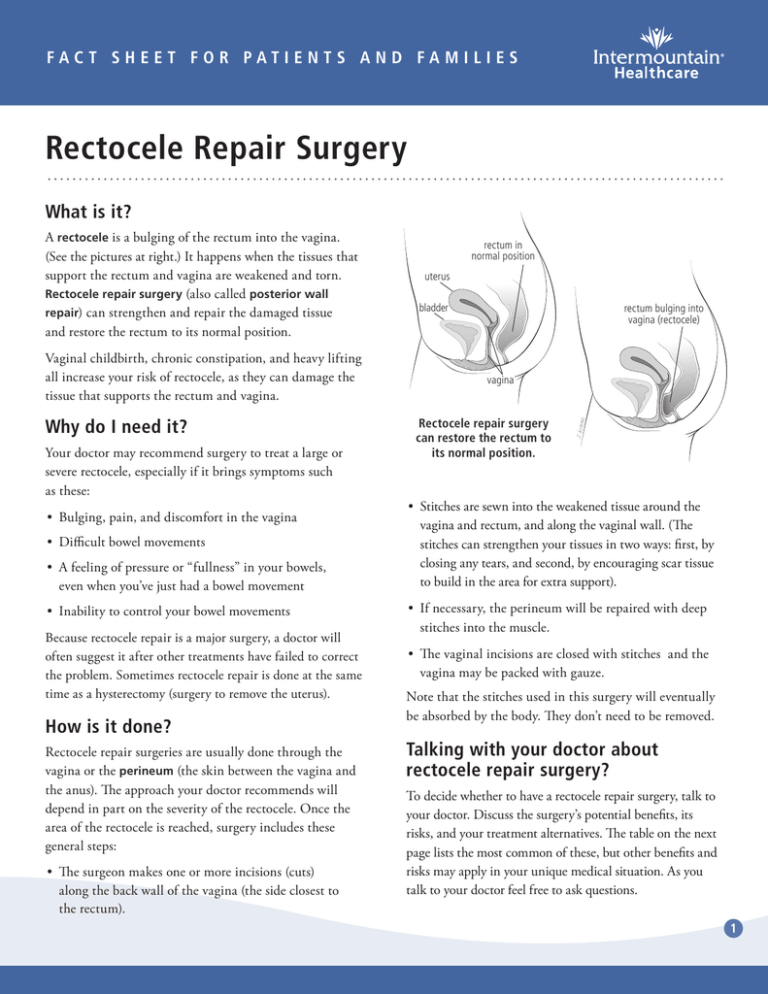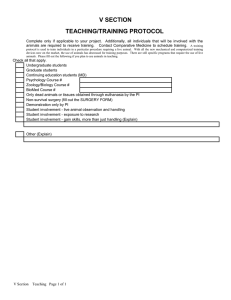
FACT SHEET FOR PATIENTS AND FAMILIES
Rectocele Repair Surgery
What is it?
A rectocele is a bulging of the rectum into the vagina.
(See the pictures at right.) It happens when the tissues that
support the rectum and vagina are weakened and torn.
Rectocele repair surgery (also called posterior wall
repair) can strengthen and repair the damaged tissue
and restore the rectum to its normal position.
Vaginal childbirth, chronic constipation, and heavy lifting
all increase your risk of rectocele, as they can damage the
tissue that supports the rectum and vagina.
Why do I need it?
Your doctor may recommend surgery to treat a large or
severe rectocele, especially if it brings symptoms such
as these:
•• Bulging, pain, and discomfort in the vagina
•• Difficult bowel movements
•• A feeling of pressure or “fullness” in your bowels,
even when you’ve just had a bowel movement
•• Inability to control your bowel movements
Because rectocele repair is a major surgery, a doctor will
often suggest it after other treatments have failed to correct
the problem. Sometimes rectocele repair is done at the same
time as a hysterectomy (surgery to remove the uterus).
How is it done?
Rectocele repair surgeries are usually done through the
vagina or the perineum (the skin between the vagina and
the anus). The approach your doctor recommends will
depend in part on the severity of the rectocele. Once the
area of the rectocele is reached, surgery includes these
general steps:
•• The surgeon makes one or more incisions (cuts)
along the back wall of the vagina (the side closest to
the rectum).
rectum in
normal position
uterus
bladder
rectum bulging into
vagina (rectocele)
vagina
Rectocele repair surgery
can restore the rectum to
its normal position.
•• Stitches are sewn into the weakened tissue around the
vagina and rectum, and along the vaginal wall. (The
stitches can strengthen your tissues in two ways: first, by
closing any tears, and second, by encouraging scar tissue
to build in the area for extra support).
•• If necessary, the perineum will be repaired with deep
stitches into the muscle.
•• The vaginal incisions are closed with stitches and the
vagina may be packed with gauze.
Note that the stitches used in this surgery will eventually
be absorbed by the body. They don’t need to be removed.
Talking with your doctor about
rectocele repair surgery?
To decide whether to have a rectocele repair surgery, talk to
your doctor. Discuss the surgery’s potential benefits, its
risks, and your treatment alternatives. The table on the next
page lists the most common of these, but other benefits and
risks may apply in your unique medical situation. As you
talk to your doctor feel free to ask questions.
1
What happens BEFORE the surgery?
Here’s what you can expect before rectocele repair surgery:
•• You’ll have blood and urine tests.
•• The day before your surgery, you’ll be asked to fast (not
eat anything), and you may be given a special liquid to
help empty your bowels.
•• Hair on your pubic area and abdomen may be clipped
to help keep the incision sites sterile.
•• To prevent infection, you’ll be given antibiotics.
•• A nurse will place an IV — a small tube put through
a needle into a vein — in your arm or wrist to deliver
fluids, medication, or blood as needed.
•• You’ll be attached to monitors and given anesthesia.
Depending on your preference and on how your surgery
will be done, you may have general anesthesia (which
puts you completely asleep during the surgery) or a
regional anesthesia (which blocks the feeling in the
lower part of your body).
•• A catheter — a thin tube — will be placed in your
bladder. The catheter drains urine from your bladder
during the surgery.
What happens AFTER the surgery?
After a rectocele repair surgery, you may need to stay in
the hospital for a few days. Here’s what to expect:
•• To help prevent blood clots, your nurses will encourage
you to walk as soon as possible after surgery. Also, a
pneumatic compression device will massage your legs by
inflating and deflating.
•• You’ll have some pain. Your doctor will prescribe
medication to help control the pain.
•• You’ll have vaginal bleeding and discharge. Sanitary
pads will help absorb this.
•• You’ll learn how to care for yourself at home during
your recovery period. Your nurse will go over the
instructions in the next section of this fact sheet and
will answer any questions you have.
How do I care for myself at home?
Recovery is different for every woman, and has a lot to
do with the type of surgery you’ve had. It can last
anywhere from 3 to 8 weeks. This section gives
information to help you know what to expect — and
what to do — as you recover at home. (Be sure to follow
the specific instructions of your own care team if they’re
different from what you see here.)
Vaginal discharge
After a rectocele repair, it’s normal to have light vaginal
discharge for up to 6 weeks. At first, the discharge tends
to be bright red or pink. Gradually, it changes to a
brownish or yellowish color. Here’s what to do to take
care of yourself:
•• Use pads to absorb discharge. Change them every
time you go to the bathroom.
•• Do NOT douche, use tampons, or have sex.
Ask your doctor when it’s okay to do so.
•• Wipe front to back after going to the bathroom.
This helps prevent infection.
•• CALL YOUR DOCTOR if the discharge becomes
foul-smelling, or if the discharge becomes heavier
than a light menstrual period.
•• GET EMERGENCY CARE if your bleeding is heavier than
a normal menstrual period, or if you pass bright red clots.
Potential benefits
Risks and potential complications
Alternatives
The aim of surgery is to repair and
strengthen the wall between the vagina
and rectum to:
•• Rectocele repair failure, or rectocele recurrence
•• Blood clots in the veins or lungs
•• Infection
•• Bleeding during or after surgery
•• Injury to the rectum or nearby organs
•• Problems related to anesthesia
•• Sexual dysfunction caused by poor healing of the vaginal
incisions or from damage to nerves
•• Pessary (a device
placed in the vagina to
hold the rectum
in place)
of rectocele repair surgery
•• Relieve pain and discomfort caused by
the rectocele
•• Improve bowel control
•• Allow for more physical activity and
more comfortable sexual activity
of rectocele repair surgery
2
Pain
Bathing
Your pain and soreness should gradually go away as the
days pass. Cramps, a bloated abdomen, and low back pain
are all common complaints. To help ease and monitor your
pain, do these things:
You may take a shower after the first 48 hours, but do
NOT soak in a bath, hot tub, or swimming pool.
However, you may take a shower or sit in a few inches of
warm water (“sitz bath”).
•• Take any medication as prescribed. Often your doctor
will prescribe medication to treat pain. Follow your
doctor’s instructions carefully.
Sexual intercourse
•• CALL YOUR DOCTOR if you have:
–– Any increase in your pain, or if pain medication
isn’t working
–– A lot of bloating or swelling in your abdomen
Don’t have sexual intercourse until your doctor
specifically says you may safely do so. Explain to your
partner: to protect the healing, it’s important to check
with the doctor before resuming sexual activity.
Physical activity and exercise
•• GET EMERGENCY CARE if you have chest pain, a cough
(not from a cold), or trouble breathing.
During your recovery, light activity is good for you.
It helps prevent problems such as gas, stiffness, weakness,
and blood clots. The trick is being active at the right level.
Here are a few guidelines:
Fatigue
•• Take it easy for the first 2 weeks. This means:
–– Pain, redness, or swelling in one leg or in your groin
Any surgery will leave you feeling tired. Your body is
healing. Try these tips to help speed the process:
–– Don’t sit or stand for more than half an hour at a time.
•• Try to get at least 8 hours of sleep each night.
Rest throughout the day.
•• Eat well balanced, healthy meals.
–– Don’t lift anything heavier than 5 pounds. And
when you’re picking things up, bend carefully at the
knees and lift slowly.
•• Tell your family what they can do to help you get
the rest you need.
–– Don’t do housework or yard work. Get your family
to pitch in, or hire help.
•• CALL YOUR DOCTOR if you become more tired
(rather than less) each day, or if you’re dizzy for more
than a few seconds at a time.
–– You can drive as soon as your pain is gone and you
are NOT taking narcotics.
Infection
You don’t need to care for the incisions made in your
vagina. The internal stitches will dissolve on their own.
However, you must be alert to any signs of infection.
•• CALL YOUR DOCTOR if you have any of these
symptoms:
–– Ongoing red bleeding from your vagina.
(It’s normal to have a small amount of bloody
discharge — but not red bleeding — at home.)
–– Fever of 100.4°F (38.0°C) or greater.
–– Flu-like symptoms (for example, chills, body
ache, fatigue, or headache).
–– Increase in pain, or pain medication that
isn’t working.
–– Don’t push, pull, or strain.
–– Take short walks several times a day. Ask someone
for support if you feel shaky or dizzy. Start with
short distances, and work up to longer walks.
•• Avoid climbing stairs if it hurts — but climb them as
soon as you can do so without pain.
•• ASK YOUR DOCTOR when it’s okay to return to work
or do more strenuous exercise. (Most patients can
return to work within 2 weeks.)
Note: You don’t need to care for the incisions made in your
vagina. The internal stitches will dissolve on their own. However,
do be alert to any signs of infection, such as fever or flu-like
symptoms. Follow all the advice on this sheet about
when to call the doctor.
3
Gas
Urination
Many women have gas after surgery. Here are some
things to do to prevent or treat gas:
•• Walk more often or a little farther every day.
After surgery, you might have trouble urinating. This might
be due to your surgery. But it may also come from pain
medication, discomfort, or anxiety. Here’s what to do:
•• Stay away from carbonated drinks — and don’t use
a straw. Drink warm drinks.
•• Don’t strain or bear down while going to the bathroom.
This can damage the area of your recent surgery.
•• Lay on your left side, with your knees drawn up to
your chest. Or get on your knees and lean forward,
placing your weight on your folded arms with your
buttocks in the air.
•• Urinate while sitting in a few inches of warm water.
•• When you have gas, gently press on your abdomen
every hour, following these steps:
•• Do Kegel exercises to strengthen the muscles around
your vagina, bowel, and bladder. To start, tighten the
muscles you use to stop the flow of urine. Hold for a
count of ten, then relax the muscles slowly. Repeat
several times a day, working up to 100 Kegels a day.
1 Take a few deep breaths. Blow out slowly.
2 Place your hands below your navel with the
fingertips touching.
3 Take a deep breath and hold it for 5 counts.
4 Breathe out slowly and completely through
your mouth while pressing in and down on
your abdomen.
5 Move your hands a half-inch and repeat steps
2 to 4 several times, moving in a circle across
your lower abdomen.
•• CALL YOUR DOCTOR if you have continuing
or severe abdominal swelling or bloating.
Constipation
Constipation after surgery can add to your discomfort.
Here’s what to do to prevent and relieve constipation:
•• Drink at least 6 to 8 glasses of water each day.
•• Eat high-fiber foods. Fresh fruit, vegetables,
and whole grain bread are good options.
•• Don’t strain with bowel movements.
•• Take a stool softener or laxative if your doctor
recommends it. Do NOT use an enema.
•• Don’t let your bladder get too full. Believe it
or not, it’s easier if you urinate more often.
•• If you can’t urinate on your own before you leave
the hospital, you may need to go home with a urinary
catheter (a small tube to drain urine from the
bladder). Until you can urinate on your own, follow
these instructions:
–– If you go home with a catheter in place,
follow the nurse’s instructions for caring for
the catheter and drainage bag. Do any exercises
you’ve been taught. And make sure you know when
and how the catheter will be removed.
–– If you need to self-catheterize, a nurse will teach
you how before you leave the hospital. Be sure to
self-catheterize as often as your nurse has told you
to — usually every 3 to 4 hours during the day.
•• CALL YOUR DOCTOR if you:
–– Can’t urinate, or have ongoing difficulty urinating
–– Have problems with your catheter, or with selfcatheterizing
–– Have bloody, cloudy, or foul-smelling urine
–– Have burning, painful, or frequent urination
•• CALL YOUR DOCTOR if you can’t relieve constipation
with the measures listed above.
© 2009–2014 Intermountain Healthcare. All rights reserved. The content presented here is for your information only. It is not a substitute for professional medical advice,
and it should not be used to diagnose or treat a health problem or disease. Please consult your healthcare provider if you have any questions or concerns. More health information
is available at intermountainhealthcare.org. Patient and Provider Publications 801-442-2963 FS118 - 11/14 Also available in Spanish.
4





